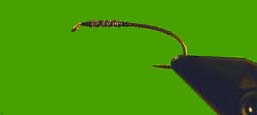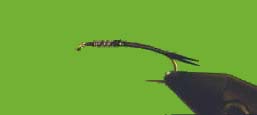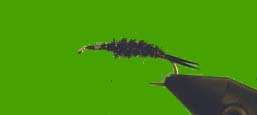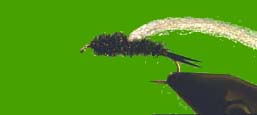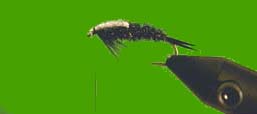|
|
|
List of BC Adventure Advertisers Site Info
Advertise With UsAwards About Us Contact Us  Kayak with Killer Whales Free Vacation Guides
BC Vacation GuidesCoastal Vacations Thompson Okanagan EcoTourism Fishing Vacations Guest Ranch Guide Romantic Getaways Wilderness Vacations Winter Vacations The Rockies Guide 
Coastal Spirits Expeditions Login |
Prior to the emergence of salmon fry Cutthroat trout must hunt down other sources of food. On many of the rivers and streams dotting the eastern Fraser Valley stonefly nymphs are a valuable source of nourishment. Requiring turbulent water to survive, stonefly nymphs crawl and forage amongst the rocks and rubble along the bottom. Feeble swimmers, the nymph's active habits often get them swept adrift, either landing further downstream or into the gullet of a feeding Cutthroat.
The Silly Creek Saviour is the creation of Ryan Pohl a sales representative based in Chilliwack. Some of Ryan's product lines include; Lamiglas Rods, Aqua Design Clothing and Guideline fly lines. New players on market, Guideline fly lines offer no memory and are a beautiful line to cast, give one a try. Ryan began experimenting with his own stonefly designs some eight or nine years ago. His quest focused around finding the right dubbing mix for the body. After much trial and error Ryan's search brought him back to a Canadian basic, black seal's fur. The natural translucence of seal's fur is tough to beat on any pattern including stonefly nymphs. For the wingcase pink pearl Krystal Flash surpassed all other competitors, including traditional mottled turkey and other wing quill choices. The Krystal Flash sparkle was just the pizzazz this design needed. The finished result was a suggestive pattern reminiscent of the traditional Idaho Nymph. In size 6 the Silly Creek Savior has become a lethal cutthroat pattern tied in larger sizes up to #2 it has become a favorite pattern of Ryan's for both summer and winter run steelhead. Ryan's primary method of presentation is a floating line and leader up to 15 feet in length. The goal is to bounce the pattern on or near the bottom to simulate the tumbling of a dislodged nymph. For the unoffended, strike indicators are a great method to control and place the fly consistently throughout the drift. This fly works in the slow margins too, even though these waters are not considered prime stonefly habitat. The Silly Creek Saviour
|
 Follow Us On Facebook Articles Fishing VancouverPhils Flybox
Bill's Big RedDunc's Floating Carey Frostbite Bloodworm Glenn's Leech Marabou Prawn Pearl Shrimp Silly Creek Saviour The Black Sally The Clouser Minnow The Collaborator The Damsel Leech Thing The Epoxy Minnow The Popsicle Stillwater Fly Tactics
Chironomid TipsDamsels Leeches Looking For Clues Scuds Writers:
Peter Caverhill Brian Chan Fred & Ann Curtis Ian Forbes Geoff Hobson Gordon Honey Steve Kaye Fred's Custom Tackle Ron Newman D. C. Reid Philip Rowley Barry Thornton |
|||||||||||||||||
|
|||||||||||||||||||

